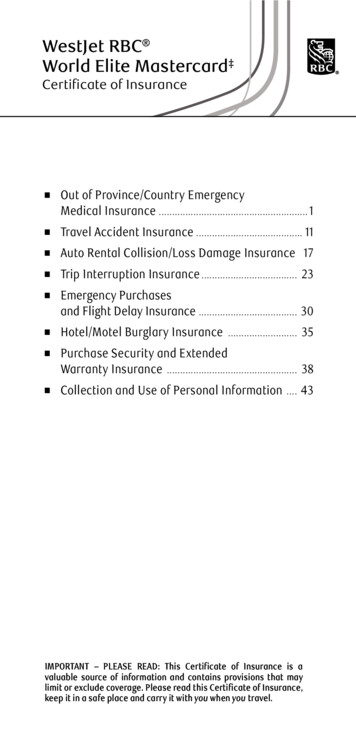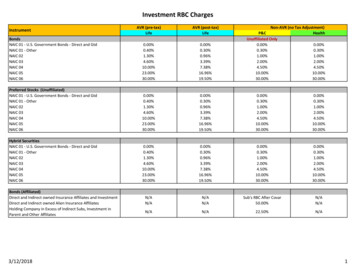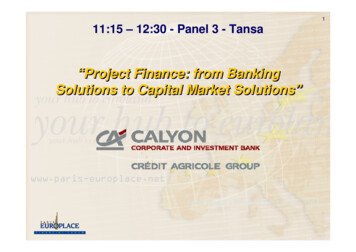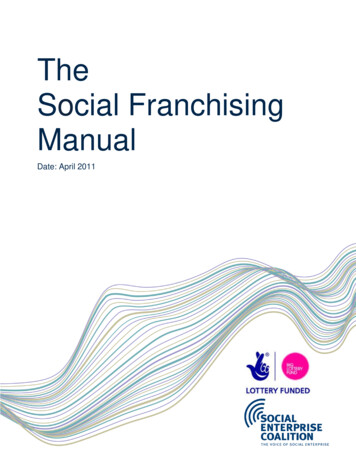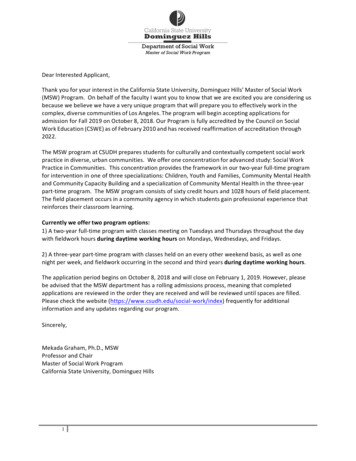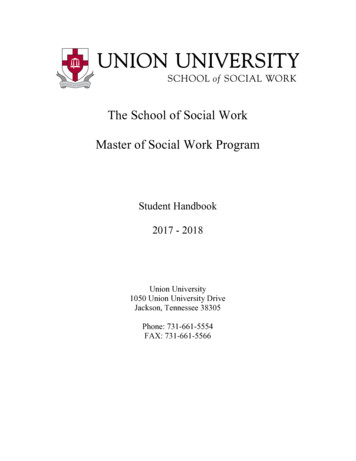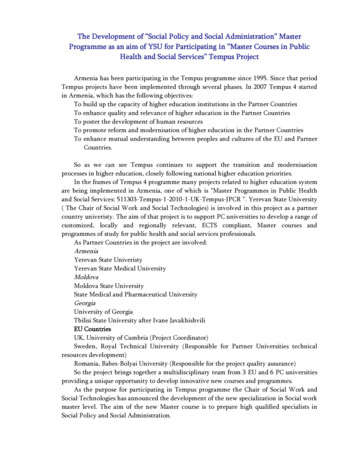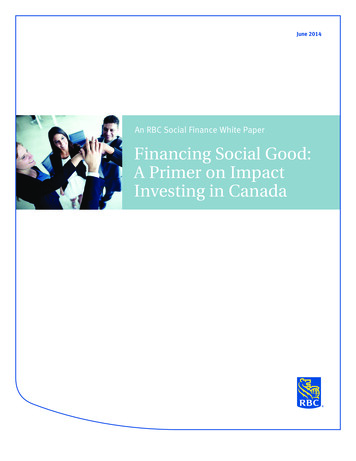
Transcription
June 2014An RBC Social Finance White PaperFinancing Social Good:A Primer on ImpactInvesting in Canada
Impact Investing in Canada 2RBC Social FinanceThis report was prepared by RBC in collaboration with the MaRS Centre for Impact Investing and Purpose Capital.About RBC Social FinanceThe Royal Bank of Canada (RBC) is Canada’s largest bank and one of the largest banks in the world basedon market capitalization. We are one of North America’s leading diversified financial services companies,and provide personal and commercial banking, wealth management services, insurance, investor servicesand capital markets products and services on a global basis. We employ approximately 79,000 full- and parttime employees who serve more than 15 million personal, business, public sector and institutional clientsthrough offices in Canada, the U.S. and 44 other countries. For more information, please visit rbc.com.RBC is recognized among the world’s financial, social and environmental leaders. In 2012, RBC launchedits social finance initiative, which is designed to ignite the growth of social finance in Canada. The initiativefinances and nurtures businesses that intentionally seek to make positive contributions to the community,and it demonstrates the opportunity to invest in a manner that delivers social, environmental and financialreturns. We hope that our commitment to social finance in Canada will not only spark entrepreneurshipand innovation, but also encourage other organizations to make similar investments that generate positivesocial and environmental change.About the MaRS Centre for Impact InvestingThe MaRS Centre for Impact Investing (the Centre), part of the MaRS Discovery District, works to increasethe use of impact investing by catalyzing new partnerships, mobilizing new capital and stimulatinginnovation to tackle social and environmental problems in Canada.The Centre supports the growing, vibrant network of players active in impact investing across Canada,and helps connect Canadian partners to the global impact investing community in developed andemerging markets.The Centre is active in market and product development, and also develops and delivers programs andservices focused on research and policy, impact measurement, education and multi-sector engagementinitiatives to mobilize private capital towards public good. The Centre is a member of the Global ImpactInvestment Network (GIIN) and a partner of GIIRS, IRIS and B Lab.About Purpose CapitalPurpose Capital is an impact investment advisory firm that mobilizes all forms of capital – financial,intellectual and social – to accelerate social progress. Purpose Capital works with asset owners and assetmanagers to build strategies that align their investments with their social and environmental impactobjectives. They inform investors and advisors on the key opportunities and issues related to these typesof investments, advise them on the design and implementation of impact investment strategies and offerapproaches to measure and report on social value creation. Purpose Capital is regularly engaged in thedevelopment of research and knowledge products, and provides in-depth, expert analysis to clients onthe key trends in, issues of and opportunities for impact investing. PreviousBack to ContentsNext
Impact Investing in Canada 3RBC Social FinanceTable of contentsForeword41.0Introduction to Impact Investing52.0The Supply Side: Impact Investors73.0Products for Impact Investors114.0Demand for Impact Investments155.0Connecting the Market: Intermediaries and Enablers206.0Impact Measurement227.0A Role for Public Policy258.0Conclusion279.0Endnotes28Appendices Previous30Next
Impact Investing in Canada 4RBC Social FinanceForewordWhat if your investment portfolio could play a role in solving some of the world’s most vexing problems? Whatif your RRSP could help fund environmental and social improvements today, and support your retirement goalstomorrow? What if the innovation and enthusiasm of entrepreneurs could be harnessed to address societal issuessuch as homelessness, unemployment and pollution? To successfully tackle the complex economic, social andenvironmental challenges we face, we will need new and innovative strategies from stakeholders in all quarters.This means governments, not-for-profits, businesses and investors working together in new ways to build longterm, sustainable solutions.Enter “impact investing,” an area of financial innovation that can provide the funding to implement theseinnovative strategies. Anyone – from large corporations to young investors just starting to save for retirement –can embrace impact investing to pursue their financial goals while also seeking social or environmental change.This report is a primer for anyone interested in understanding impact investing and how it is taking shape acrossCanada. It identifies opportunities for astute first-movers to participate in this growing field, drawing on researchfrom the State of the Nation Report on Impact Investing1, prepared by the MaRS Centre for Impact Investing andPurpose Capital with support from RBC.The Canadian Task Force on Social FinanceIn 2010, The Canadian Task Force on Social Finance issued a report called “Mobilizing PrivateCapital for Public Good,” which made seven recommendations on how to build a Canadian impactinvesting marketplace to address three challenges: C apital mobilization: How to unlock new sources of capital (e.g. foundationendowments, pension funds, first-loss capital from the government) for public good. E nabling tax and regulatory environment: How to make it easier for charities andnon-profits to start enterprises to generate revenue. I nvestment pipeline: How to provide social entrepreneurs and enterprisingnon-profits with needed business training.The seven recommendations, which are summarized in Appendix 1, provide a national frameworkfor advancing social finance in Canada. PreviousBack to ContentsNext
Impact Investing in Canada 5RBC Social Finance1.0 Introduction to Impact InvestingThe term “impact investing” was first coined in 2007, but the most widely cited definition comes from a2010 report by J.P. Morgan, the Global Impact Investing Network (GIIN) and the Rockefeller Foundation,which described impact investments as “investments intended to create positive impact beyondfinancial returns.”2Impact investing differs from traditional investing in three important ways: I nvestor intention: Investors seek to allocate capital (debt, equity or hybrids) to investments where theyexpect to receive both a financial return (ranging from return of principal to market-beating returns)and a defined societal impact. I nvestee intention: Business models for investees (whether they are for-profit or non-profit enterprises,funds or other financial vehicles) are intentionally constructed to deliver financial and social value. I mpact measurement: Investors and investees are able to demonstrate how their intentions translateinto measureable social impact.Impact investing is part of a range of investment approaches that incorporate varying degrees of socialand environmental considerations. At one end of the spectrum is traditional investing, where investorsplace financial capital into a for-profit company to generate risk-adjusted, competitive financial returns.At the other end of the spectrum is venture philanthropy, which combines grant-making and theinvestment of human and financial resources in social-purpose organizations to foster social impact. Thefigure below illustrates where impact investing is situated across a continuum of investment approaches.While “responsible investments” and “socially responsible investments” (or “SRIs”) are very importantto publicly traded securities markets, they are not typically considered impact investments. Theseinvestments are made with environmental and social risks in mind, but the investors and investees areusually not intentionally seeking a specific measurable social or environmental impact from theinvestment or business.Continuum of Investment ApproachesIMPACT INVESTMENTTraditionalResponsibleInvesting (RI)SociallyResponsibleInvesting itive ReturnsESG Risk ManagementHigh Impact SolutionsInvestments madewith the motiveof attaining afinancial returnwith limited orno focus onEnvironmental,Social orGovernance (ESG)factors.Investing in amanner thatscreens outcertain sectors(e.g., tobacco,weapons) as acomponent offinancial riskmanagement.An approachthat involvescomprehensivenegative andpositive screeningof ESG risks asa part of theinvestmentanalysis process.An approach thatfocuses on one ormore issue areaswhere social orenvironmentalneeds havecreated acommercial growthopportunity formarket-rate returns.Investments madein issue areaswhere achievingmeasurable socialor environmentalimpact may requiresome financialtrade-off.Social enterprisefunding in avariety of forms,with a range ofreturn possibilities.Investorinvolvement/support iscommon.Source: Adapted from Bridges Venture Research (2012). “Sustainable & Impact Investment – How we define the market.” Retrieved fromwww.bridgesventures.com/links-research. PreviousBack to ContentsNext
Impact Investing in Canada 6RBC Social Finance1.1 Impact Investing in CanadaImpact investing is rooted in a rich history of social investment in Canada, from the birth of the creditunion movement in the early 1900s to the growth of community loan funds and the creation of sociallyresponsible investment (SRI) funds in the early part of the 21st century. Impact investing builds on thisrich history as an approach to create tangible and long-lasting social change through investment practices.Impact investing has been gaining attention and popularity in recent years. Some of the factors driving this recentinterest include the following: C omplex issues require new solutions. There is growing recognition that global problems like povertyand ecological degradation cannot be solved by increasingly stretched government and philanthropicresources; they also require business expertise and private capital. S ustainability is becoming synonymous with good business practice and responsible citizenry.Businesses are increasingly seeking to be recognized for their sustainability efforts, as demonstrated bythe rise in certifications such as B Corps and Fair Trade labels. Sustainability-focused private companiesoften look to impact investors to help finance business growth and expansion. N ot-for-profits and charities are developing new business models to expand their revenue sourcesbeyond grants and philanthropic contributions. A growing class of investors is looking to align their personal values with their investment principles.Investors are seeking new ways to unlock solutions that blend a financial return with social outcomes.“According to a June 2012 report by US SIF, a group that promotes sustainable and responsible investing,more than 3.74 trillion is now ‘responsibly’ managed in the US, up from 639 billion in 1995.”3Activity in the Canadian impact investing marketplace has been concentrated on mobilizing and deployingcapital. This capital has been able to access a growing range of impact investing products available acrossa number of different asset classes, sectors and regions. New intermediaries are forming to facilitatetransactions between the supply and demand sides of the market, and enhance tools to measure anddemonstrate impact.1.2 Impact Investing Market ElementsLike traditional financial markets, the impact investing marketplace includes those who supply capital,those who demand capital, and intermediaries and enablers. Impact investors supply the capital that fundsprojects, programs and businesses that deliver solutions to social and environmental problems. Impactinvestors can include governments, individuals, foundations, banks and pension funds. The demand sideof the market includes companies in myriad sectors, non-profits and charities, cooperatives, and projectsthat need capital to open, operate or expand activities. Meanwhile, intermediaries and enablers support theplacement of investments and the development of financial products, and can also play a role in helpingentrepreneurs and organizations become investment-ready. PreviousBack to ContentsNext
Impact Investing in Canada 7RBC Social Finance2.0 The Supply Side: Impact InvestorsAnyone can be an impact investor. Early adopters have been primarily investors with a strong personalinterest in achieving social and environmental returns and the financial flexibility to experiment. As impactinvesting moves into the mainstream, it should become more accessible to all investors.There are several types of investors that are seeking to deploy their capital through impact investing.Impact investors who seek a market rate of return are typically called “finance first” investors, while thosewho seek investments primarily for their social or environmental impact are often called “impact first”investors. Many investors hold portfolios that combine investments that are finance first, impact first andall things in between.An industry survey in 2013 determined that the supply of capital for impact investing in Canada grew by20% between 2010 and 2012, reaching 5.3 billion in 2012.4 What follows is a description of the supply ofimpact investing capital in Canada or, in other words, a closer look at the types of impact investors.2.1 High Net Worth Individuals and Angel InvestorsPutting personal wealth towards greater goodWealth amongst Canada’s high net worth individuals (HNWI) – those with over US 1 million in investableassets – grew to a record 897 billion in 2012.5 Canada ranks seventh in the world with 298,000 HNWI,a number that is growing by 6.5% annually.6 Furthermore, Canada’s population of ultra high net worthindividuals (UHWNI), with more than 30 million in investable assets, is gro
Investment Network (GIIN) and a partner of GIIRS, IRIS and B Lab. About Purpose Capital Purpose Capital is an impact investment advisory firm that mobilizes all forms of capital – financial, intellectual and social – to accelerate social progress. Purpose Capital works with asset owners and asset managers to build strategies that align their investments with their social and environmental .
